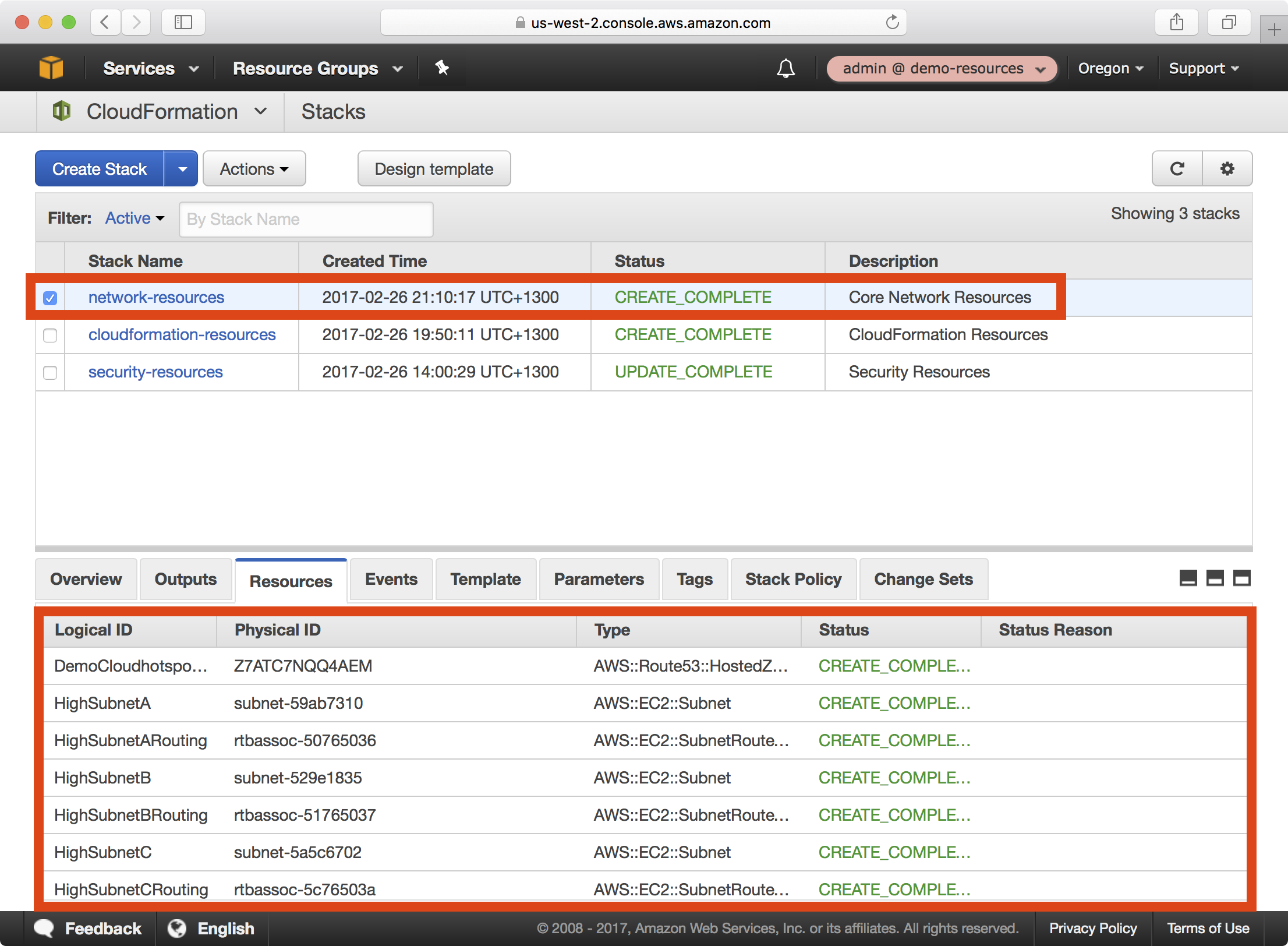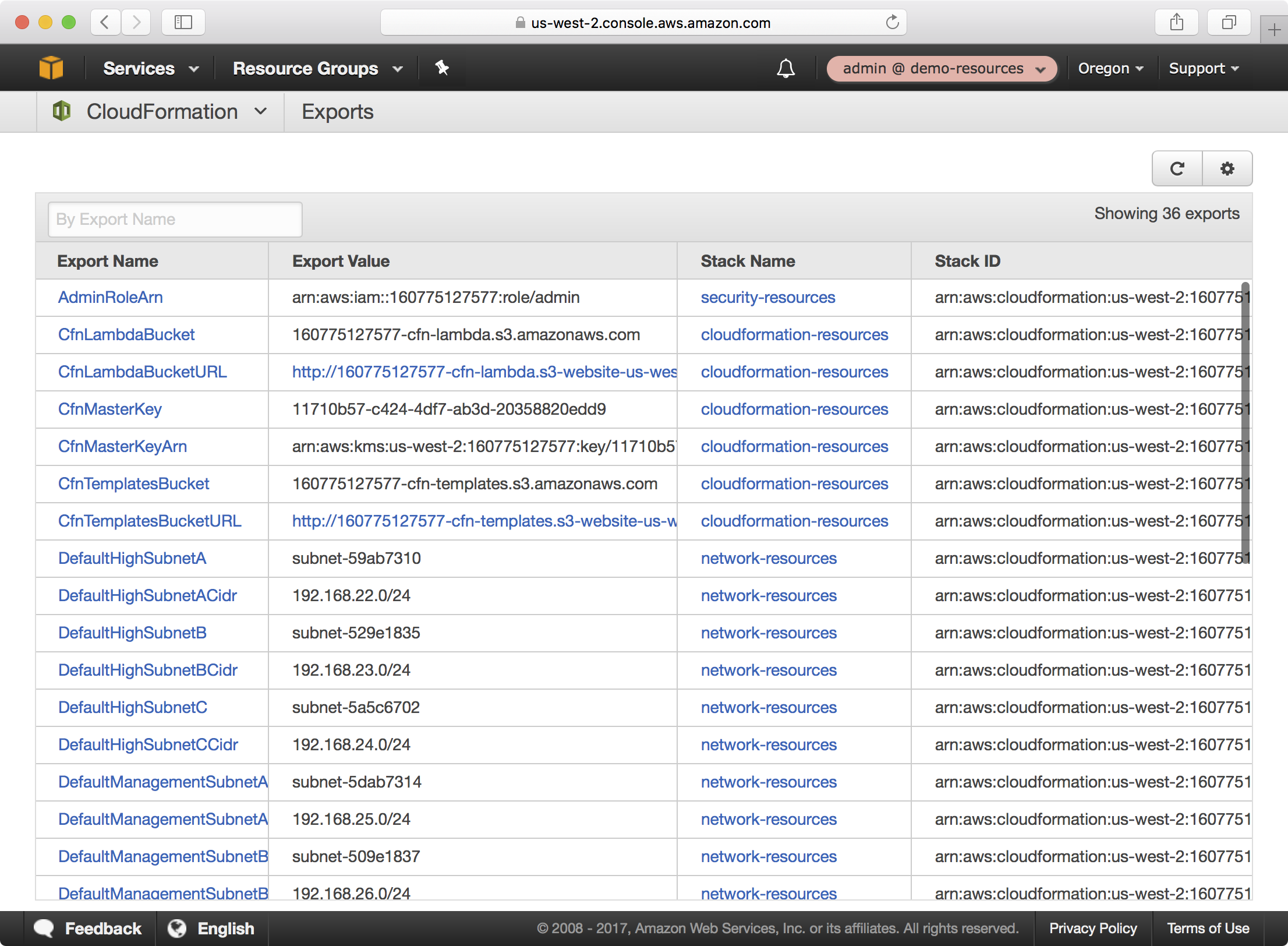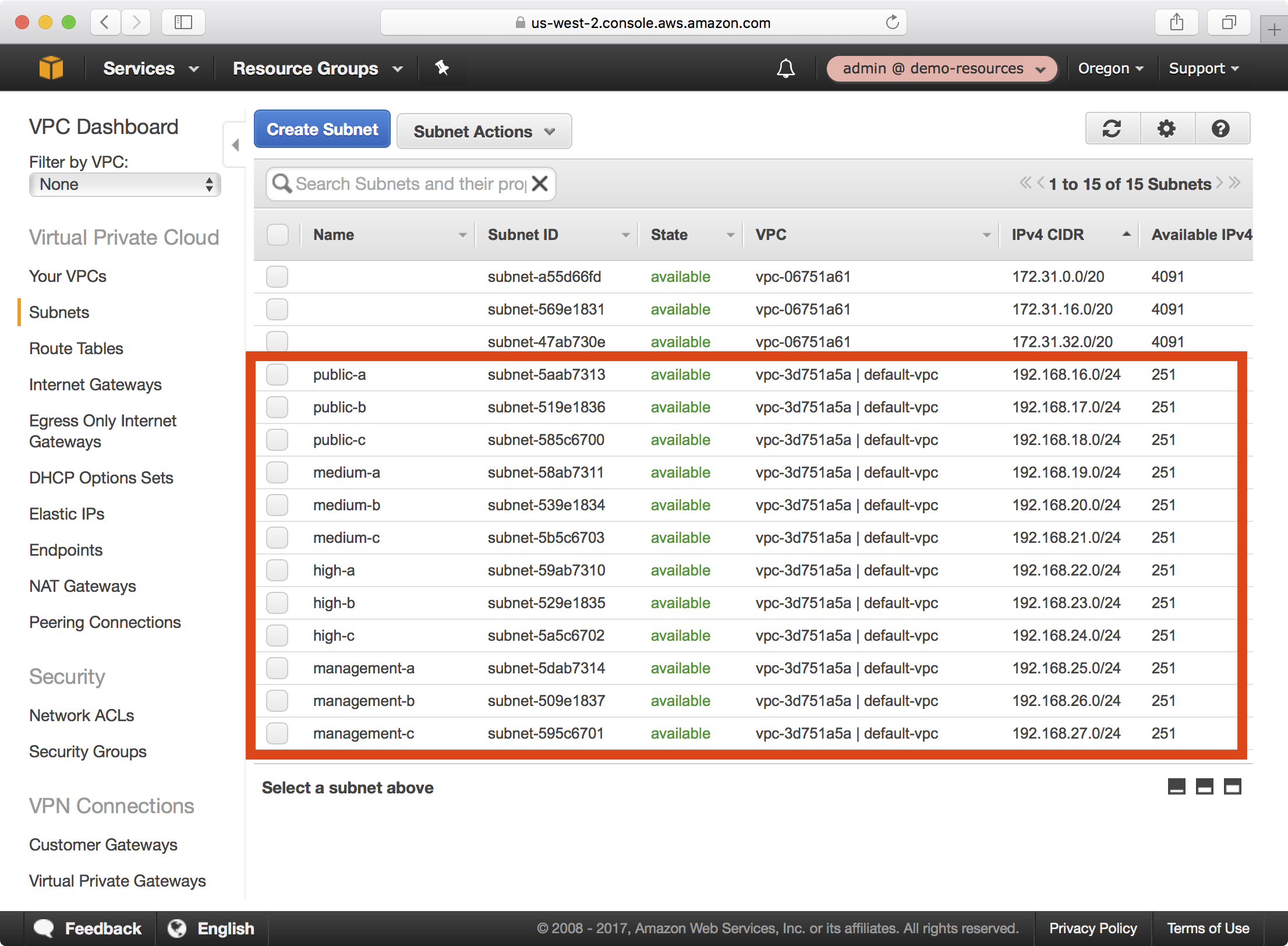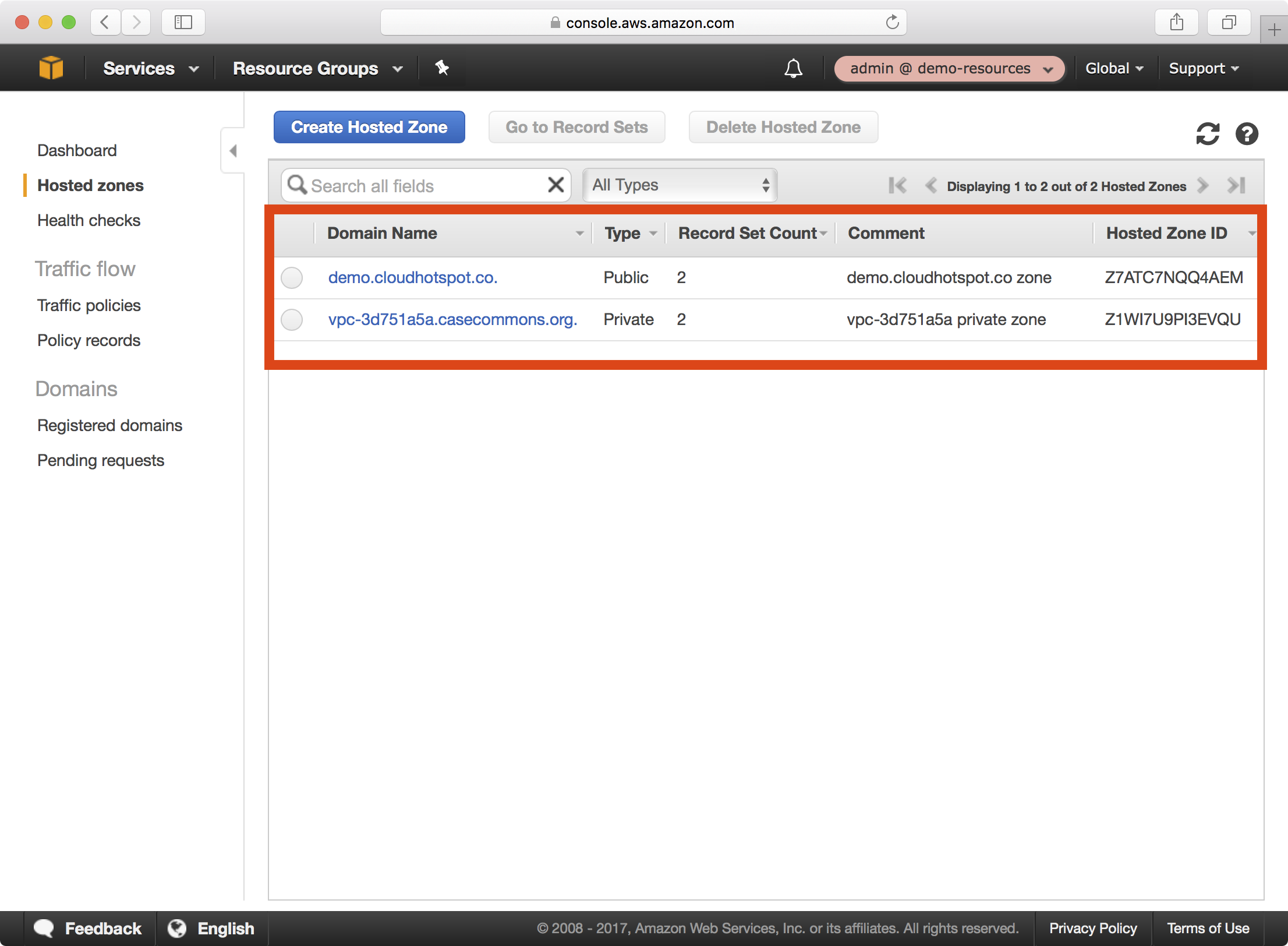Network Resources
Introduction
The aws-cloudformation role includes a network resources template that is designed to define the following AWS resources:
- Subnets
- Route Tables
- Internet Gateways
- DHCP Option Sets
- VPC Endpoints
- VPC Flow Logs
- Route53 Public Zones
- Route53 Private Zones
Note
Before commencing the tasks below, ensure you have successfully completed all tasks in the following sections:
Creating the Playbook
We will get started by establishing a network resources playbook that defines network resources for Demo Resources account.
1. Clone the AWS Starter to a local folder called demo-network-resources and re-initialise the Git repository.
$ git clone git@github.com:casecommons/aws-starter.git demo-network-resources
Cloning into 'demo-network-resources'...
remote: Counting objects: 22, done.
remote: Compressing objects: 100% (14/14), done.
remote: Total 22 (delta 4), reused 22 (delta 4), pack-reused 0
Receiving objects: 100% (22/22), done.
Resolving deltas: 100% (4/4), done
$ cd demo-network-resources
$ rm -rf .git
$ git init
Initialized empty Git repository in /Users/jmenga/Source/casecommons/demo-network-resources/.git/
2. Update the roles/requirements.yml file to the desired versions for each role:
# You can specify git tag, commit or branch for the version property
- src: git@github.com:casecommons/aws-cloudformation.git
scm: git
version: 0.7.0
name: aws-cloudformation
- src: git@github.com:casecommons/aws-sts.git
scm: git
version: 0.1.2
name: aws-sts
3. Install the roles using the ansible-galaxy command as demonstrated below:
$ ansible-galaxy install -r roles/requirements.yml --force
- extracting aws-cloudformation to /Users/jmenga/Source/casecommons/demo-network-resources/roles/aws-cloudformation
- aws-cloudformation was installed successfully
- extracting aws-sts to /Users/jmenga/Source/casecommons/demo-network-resources/roles/aws-sts
- aws-sts was installed successfully
4. Modify the group_vars/all/vars.yml file, which contains global settings for the playbook:
# Stack Settings
cf_stack_name: network-resources
cf_stack_template: "templates/network.yml.j2"
cf_stack_tags:
org:business:owner: Casecommons
org:business:product: Network Resources
org:business:severity: High
org:tech:environment: "{{ env }}"
org:tech:contact: pema@casecommons.org
# CloudFormation settings
# This sets a policy that disables updates to existing resources
# This requires you to explicitly set the cf_disable_stack_policy flag to true when running the playbook
cf_stack_policy:
Statement:
- Effect: "Deny"
Action: "Update:*"
Principal: "*"
Resource: "*"
Notice that we reference the templates/network.yml.y2 template that is embedded within the aws-cloudformation role.
5. Remove the local templates folder, since we are using a template that is embedded within the aws-cloudformation role:
$ rm -rf templates
Defining a New Environment
We will now add a new environment called demo-resources to the playbook, which will be used to create CloudFormation resources in the demo-resources account.
1. Modify the inventory file so that it defines a single environment called demo-resources, ensuring you specify ansible_connection=local:
[demo-resources]
demo-resources ansible_connection=local
2. Remove the group_vars/non-prod environment folder that is included in the starter template:
$ rm -rf group_vars/non-prod
3. Create a file called group_vars/demo-resources/vars.yml, which will hold all environment specific configuration for the demo-resources environment:
$ mkdir -p group_vars/demo-resources
$ touch group_vars/demo-resources/vars.yml
4. Add the following settings to group_vars/demo-resources/vars.yml:
# STS role in the target AWS account to assume
sts_role_arn: "arn:aws:iam::160775127577:role/admin"
# VPC CIDR Block
config_vpc_cidr: 192.168.16.0/20
# VPC Domain Settings
# This will configure a private Route53 zone of <vpc-id>.<config_vpc_root_domain>
config_vpc_root_domain: casecommons.org
# AZ Count
config_az_count: 3
# Public Route53 Zones
config_public_domains:
- demo.cloudhotspot.co
Here we target the demo-resources account by specifying the demo-resources IAM admin role in the sts_role_arn variable, whilst the following settings customize the network resources that will be created:
config_vpc_cidr- defines the CIDR block for the VPC that will be created. The CIDR block must be large enough to create the required number of subnets, which can be calculated by multiplying the number of security zones (4 by default) by the number of availability zones (3 as defined byconfig_az_count) - i.e. 12 subnets with a default size/subnet mask of /24 or 255.255.255.0. The value of192.168.16.0/20will accommodate 16 x /24 subnets, so is sufficiently sized.config_vpc_root_domain- when configured creates a Route53 private zone in the format<vpc-id>.<config_vpc_root_domain>. In this example, if the VPC ID isvpc-1234567then the configuration above would create a private zone ofvpc-1234567.casecommons.org.config_az_count- defines the number of availability zones to create subnets in.config_public_domains- defines a list of public Route53 domains or zones to create
Running the Playbook
Now that we’ve defined environment settings for the demo-resources environment, let’s run the playbook to create network resources for the environment.
1. Ensure your local AWS environment is configured to target the demo-resources account:
$ export AWS_PROFILE=demo-resources-admin
2. Run the Ansible playbook targeting the demo-resources environment as demonstrated below:
$ ansible-playbook site.yml -e env=demo-resources
PLAY [Assume Role] *************************************************************
TASK [aws-sts : set_fact] ******************************************************
ok: [demo-resources]
TASK [aws-sts : checking if sts functions are sts_disabled] ********************
skipping: [demo-resources]
TASK [aws-sts : setting empty sts_session_output result] ***********************
skipping: [demo-resources]
TASK [aws-sts : setting sts_creds if legacy AWS credentials are present (e.g. for Ansible Tower)] ***
skipping: [demo-resources]
TASK [aws-sts : assume sts role] ***********************************************
Enter MFA code: ******
ok: [demo-resources]
...
...
TASK [aws-cloudformation : set local path fact if s3 upload disabled] **********
ok: [demo-resources]
TASK [aws-cloudformation : configure application stack] ************************
...
...
PLAY RECAP *********************************************************************
demo-resources : ok=20 changed=1 unreachable=0 failed=0
3. The playbook will take a few minutes to create the CloudFormation stack and associated resources. Whilst the CloudFormation stack is being created, you can review the CloudFormation stack that was generated in the build/<timestamp> folder:
$ tree build
build
└── 20170226211011
├── network-resources-config.json
├── network-resources-policy.json
├── network-resources-stack.json
└── network-resources-stack.yml
The following shows the network-resources-stack.yml file that was generated and uploaded to CloudFormation:
AWSTemplateFormatVersion: "2010-09-09"
Description: Core Network Resources
Resources:
Vpc:
Type: "AWS::EC2::VPC"
Properties:
CidrBlock: "192.168.16.0/20"
EnableDnsSupport: True
EnableDnsHostnames: True
Tags:
- Key: "Name"
Value: "default-vpc"
InternetGateway:
Type: "AWS::EC2::InternetGateway"
Properties:
Tags:
- Key: "Name"
Value: "default-igw"
- Key: "org:security:level"
Value: "public"
InternetGatewayAttachment:
Type: "AWS::EC2::VPCGatewayAttachment"
Properties:
InternetGatewayId: { "Ref": "InternetGateway" }
VpcId:
Ref: Vpc
PublicRouteTable:
Type: "AWS::EC2::RouteTable"
Properties:
VpcId:
Ref: Vpc
Tags:
- Key: "Name"
Value: "default-public-route-table"
- Key: "org:security:level"
Value: "public"
PrivateRouteTable:
Type: "AWS::EC2::RouteTable"
Properties:
VpcId:
Ref: Vpc
Tags:
- Key: "Name"
Value: "default-private-route-table"
- Key: "org:security:level"
Value: "mixed"
PublicDefaultRoute:
Type: "AWS::EC2::Route"
DependsOn: "InternetGatewayAttachment"
Properties:
DestinationCidrBlock: "0.0.0.0/0"
GatewayId: { "Ref": "InternetGateway" }
RouteTableId: { "Ref": "PublicRouteTable" }
S3Endpoint:
Type: "AWS::EC2::VPCEndpoint"
Properties:
RouteTableIds:
- { "Ref" : "PublicRouteTable" }
- { "Ref" : "PrivateRouteTable" }
ServiceName:
Fn::Sub: "com.amazonaws.${AWS::Region}.s3"
VpcId:
Ref: Vpc
VpcFlowLog:
Type: "AWS::EC2::FlowLog"
Properties:
DeliverLogsPermissionArn:
Fn::Sub: "arn:aws:iam::${AWS::AccountId}:role/${VpcFlowLogRole}"
LogGroupName:
Fn::Sub: ${AWS::StackName}/vpc/FlowLog
ResourceId: { "Ref": "Vpc" }
ResourceType: "VPC"
TrafficType: "ALL"
VpcFlowLogRole:
Type: "AWS::IAM::Role"
Properties:
AssumeRolePolicyDocument:
Version: "2012-10-17"
Statement:
- Effect: "Allow"
Principal:
Service: [ "vpc-flow-logs.amazonaws.com" ]
Action: [ "sts:AssumeRole" ]
Path: "/"
Policies:
- PolicyName: CloudWatchLogs
PolicyDocument:
Version: "2012-10-17"
Statement:
- Effect: Allow
Action:
- "logs:CreateLogGroup"
- "logs:CreateLogStream"
- "logs:PutLogEvents"
- "logs:DescribeLogGroups"
- "logs:DescribeLogStreams"
Resource:
Fn::Sub: "arn:aws:logs:${AWS::Region}:${AWS::AccountId}:log-group:${AWS::StackName}/vpc/FlowLog*"
VpcFlowLogGroup:
Type: "AWS::Logs::LogGroup"
DeletionPolicy: "Delete"
Properties:
LogGroupName:
Fn::Sub: ${AWS::StackName}/vpc/FlowLog
RetentionInDays: 7
VpcPrivateZone:
Type: "AWS::Route53::HostedZone"
Properties:
HostedZoneConfig:
Comment:
Fn::Sub: "${Vpc} private zone"
HostedZoneTags:
- Key: "Name"
Value:
Fn::Sub: "${Vpc}.casecommons.org"
- Key: "org:security:level"
Value: "mixed"
Name:
Fn::Sub: "${Vpc}.casecommons.org"
VPCs:
- VPCId: { "Ref": "Vpc" }
VPCRegion: { "Ref": "AWS::Region" }
DemoCloudhotspotCoZone:
Type: "AWS::Route53::HostedZone"
Properties:
HostedZoneConfig:
Comment: "demo.cloudhotspot.co zone"
HostedZoneTags:
- Key: "Name"
Value: "demo.cloudhotspot.co"
- Key: "org:security:level"
Value: "mixed"
Name: "demo.cloudhotspot.co"
PublicSubnetA:
Type: "AWS::EC2::Subnet"
Properties:
VpcId:
Ref: Vpc
CidrBlock: "192.168.16.0/24"
AvailabilityZone:
Fn::Sub: "${AWS::Region}a"
Tags:
- Key: "Name"
Value: "public-a"
- Key: "org:security:level"
Value: "public"
PublicSubnetARouting:
Type: "AWS::EC2::SubnetRouteTableAssociation"
Properties:
RouteTableId: { "Ref": "PublicRouteTable" }
SubnetId: { "Ref": "PublicSubnetA" }
PublicSubnetB:
Type: "AWS::EC2::Subnet"
Properties:
VpcId:
Ref: Vpc
CidrBlock: "192.168.17.0/24"
AvailabilityZone:
Fn::Sub: "${AWS::Region}b"
Tags:
- Key: "Name"
Value: "public-b"
- Key: "org:security:level"
Value: "public"
PublicSubnetBRouting:
Type: "AWS::EC2::SubnetRouteTableAssociation"
Properties:
RouteTableId: { "Ref": "PublicRouteTable" }
SubnetId: { "Ref": "PublicSubnetB" }
PublicSubnetC:
Type: "AWS::EC2::Subnet"
Properties:
VpcId:
Ref: Vpc
CidrBlock: "192.168.18.0/24"
AvailabilityZone:
Fn::Sub: "${AWS::Region}c"
Tags:
- Key: "Name"
Value: "public-c"
- Key: "org:security:level"
Value: "public"
PublicSubnetCRouting:
Type: "AWS::EC2::SubnetRouteTableAssociation"
Properties:
RouteTableId: { "Ref": "PublicRouteTable" }
SubnetId: { "Ref": "PublicSubnetC" }
MediumSubnetA:
Type: "AWS::EC2::Subnet"
Properties:
VpcId:
Ref: Vpc
CidrBlock: "192.168.19.0/24"
AvailabilityZone:
Fn::Sub: "${AWS::Region}a"
Tags:
- Key: "Name"
Value: "medium-a"
- Key: "org:security:level"
Value: "medium"
MediumSubnetARouting:
Type: "AWS::EC2::SubnetRouteTableAssociation"
Properties:
RouteTableId: { "Ref": "PrivateRouteTable" }
SubnetId: { "Ref": "MediumSubnetA" }
MediumSubnetB:
Type: "AWS::EC2::Subnet"
Properties:
VpcId:
Ref: Vpc
CidrBlock: "192.168.20.0/24"
AvailabilityZone:
Fn::Sub: "${AWS::Region}b"
Tags:
- Key: "Name"
Value: "medium-b"
- Key: "org:security:level"
Value: "medium"
MediumSubnetBRouting:
Type: "AWS::EC2::SubnetRouteTableAssociation"
Properties:
RouteTableId: { "Ref": "PrivateRouteTable" }
SubnetId: { "Ref": "MediumSubnetB" }
MediumSubnetC:
Type: "AWS::EC2::Subnet"
Properties:
VpcId:
Ref: Vpc
CidrBlock: "192.168.21.0/24"
AvailabilityZone:
Fn::Sub: "${AWS::Region}c"
Tags:
- Key: "Name"
Value: "medium-c"
- Key: "org:security:level"
Value: "medium"
MediumSubnetCRouting:
Type: "AWS::EC2::SubnetRouteTableAssociation"
Properties:
RouteTableId: { "Ref": "PrivateRouteTable" }
SubnetId: { "Ref": "MediumSubnetC" }
HighSubnetA:
Type: "AWS::EC2::Subnet"
Properties:
VpcId:
Ref: Vpc
CidrBlock: "192.168.22.0/24"
AvailabilityZone:
Fn::Sub: "${AWS::Region}a"
Tags:
- Key: "Name"
Value: "high-a"
- Key: "org:security:level"
Value: "high"
HighSubnetARouting:
Type: "AWS::EC2::SubnetRouteTableAssociation"
Properties:
RouteTableId: { "Ref": "PrivateRouteTable" }
SubnetId: { "Ref": "HighSubnetA" }
HighSubnetB:
Type: "AWS::EC2::Subnet"
Properties:
VpcId:
Ref: Vpc
CidrBlock: "192.168.23.0/24"
AvailabilityZone:
Fn::Sub: "${AWS::Region}b"
Tags:
- Key: "Name"
Value: "high-b"
- Key: "org:security:level"
Value: "high"
HighSubnetBRouting:
Type: "AWS::EC2::SubnetRouteTableAssociation"
Properties:
RouteTableId: { "Ref": "PrivateRouteTable" }
SubnetId: { "Ref": "HighSubnetB" }
HighSubnetC:
Type: "AWS::EC2::Subnet"
Properties:
VpcId:
Ref: Vpc
CidrBlock: "192.168.24.0/24"
AvailabilityZone:
Fn::Sub: "${AWS::Region}c"
Tags:
- Key: "Name"
Value: "high-c"
- Key: "org:security:level"
Value: "high"
HighSubnetCRouting:
Type: "AWS::EC2::SubnetRouteTableAssociation"
Properties:
RouteTableId: { "Ref": "PrivateRouteTable" }
SubnetId: { "Ref": "HighSubnetC" }
ManagementSubnetA:
Type: "AWS::EC2::Subnet"
Properties:
VpcId:
Ref: Vpc
CidrBlock: "192.168.25.0/24"
AvailabilityZone:
Fn::Sub: "${AWS::Region}a"
Tags:
- Key: "Name"
Value: "management-a"
- Key: "org:security:level"
Value: "management"
ManagementSubnetARouting:
Type: "AWS::EC2::SubnetRouteTableAssociation"
Properties:
RouteTableId: { "Ref": "PrivateRouteTable" }
SubnetId: { "Ref": "ManagementSubnetA" }
ManagementSubnetB:
Type: "AWS::EC2::Subnet"
Properties:
VpcId:
Ref: Vpc
CidrBlock: "192.168.26.0/24"
AvailabilityZone:
Fn::Sub: "${AWS::Region}b"
Tags:
- Key: "Name"
Value: "management-b"
- Key: "org:security:level"
Value: "management"
ManagementSubnetBRouting:
Type: "AWS::EC2::SubnetRouteTableAssociation"
Properties:
RouteTableId: { "Ref": "PrivateRouteTable" }
SubnetId: { "Ref": "ManagementSubnetB" }
ManagementSubnetC:
Type: "AWS::EC2::Subnet"
Properties:
VpcId:
Ref: Vpc
CidrBlock: "192.168.27.0/24"
AvailabilityZone:
Fn::Sub: "${AWS::Region}c"
Tags:
- Key: "Name"
Value: "management-c"
- Key: "org:security:level"
Value: "management"
ManagementSubnetCRouting:
Type: "AWS::EC2::SubnetRouteTableAssociation"
Properties:
RouteTableId: { "Ref": "PrivateRouteTable" }
SubnetId: { "Ref": "ManagementSubnetC" }
Outputs:
DefaultVpcId:
Description: "Default VPC Identifier"
Value:
Ref: Vpc
Export:
Name: "DefaultVpcId"
DefaultVpcCidr:
Description: "Default VPC CIDR Block"
Value: "192.168.16.0/20"
Export:
Name: "DefaultVpcCidr"
DefaultVpcDnsServer:
Description: "Default VPC AWS Provided DNS Server IP Address"
Value: "192.168.16.2"
Export:
Name: "DefaultVpcDnsServer"
DefaultVpcDomain:
Description: "Default VPC Domain"
Value:
Fn::Sub: "${Vpc}.casecommons.org"
Export:
Name: "DefaultVpcDomain"
DefaultVpcZone:
Description: "Default VPC Zone"
Value:
Fn::Sub: "${Vpc}.casecommons.org."
Export:
Name: "DefaultVpcZone"
DefaultPublicSubnetA:
Description: "DefaultPublic Subnet Availability Zone A"
Value: { "Ref": "PublicSubnetA" }
Export:
Name: "DefaultPublicSubnetA"
DefaultPublicSubnetACidr:
Description: "Default Public Subnet Availability Zone A CIDR"
Value: "192.168.16.0/24"
Export:
Name: "DefaultPublicSubnetACidr"
DefaultPublicSubnetB:
Description: "DefaultPublic Subnet Availability Zone B"
Value: { "Ref": "PublicSubnetB" }
Export:
Name: "DefaultPublicSubnetB"
DefaultPublicSubnetBCidr:
Description: "Default Public Subnet Availability Zone B CIDR"
Value: "192.168.17.0/24"
Export:
Name: "DefaultPublicSubnetBCidr"
DefaultPublicSubnetC:
Description: "DefaultPublic Subnet Availability Zone C"
Value: { "Ref": "PublicSubnetC" }
Export:
Name: "DefaultPublicSubnetC"
DefaultPublicSubnetCCidr:
Description: "Default Public Subnet Availability Zone C CIDR"
Value: "192.168.18.0/24"
Export:
Name: "DefaultPublicSubnetCCidr"
DefaultMediumSubnetA:
Description: "DefaultMedium Subnet Availability Zone A"
Value: { "Ref": "MediumSubnetA" }
Export:
Name: "DefaultMediumSubnetA"
DefaultMediumSubnetACidr:
Description: "Default Medium Subnet Availability Zone A CIDR"
Value: "192.168.19.0/24"
Export:
Name: "DefaultMediumSubnetACidr"
DefaultMediumSubnetB:
Description: "DefaultMedium Subnet Availability Zone B"
Value: { "Ref": "MediumSubnetB" }
Export:
Name: "DefaultMediumSubnetB"
DefaultMediumSubnetBCidr:
Description: "Default Medium Subnet Availability Zone B CIDR"
Value: "192.168.20.0/24"
Export:
Name: "DefaultMediumSubnetBCidr"
DefaultMediumSubnetC:
Description: "DefaultMedium Subnet Availability Zone C"
Value: { "Ref": "MediumSubnetC" }
Export:
Name: "DefaultMediumSubnetC"
DefaultMediumSubnetCCidr:
Description: "Default Medium Subnet Availability Zone C CIDR"
Value: "192.168.21.0/24"
Export:
Name: "DefaultMediumSubnetCCidr"
DefaultHighSubnetA:
Description: "DefaultHigh Subnet Availability Zone A"
Value: { "Ref": "HighSubnetA" }
Export:
Name: "DefaultHighSubnetA"
DefaultHighSubnetACidr:
Description: "Default High Subnet Availability Zone A CIDR"
Value: "192.168.22.0/24"
Export:
Name: "DefaultHighSubnetACidr"
DefaultHighSubnetB:
Description: "DefaultHigh Subnet Availability Zone B"
Value: { "Ref": "HighSubnetB" }
Export:
Name: "DefaultHighSubnetB"
DefaultHighSubnetBCidr:
Description: "Default High Subnet Availability Zone B CIDR"
Value: "192.168.23.0/24"
Export:
Name: "DefaultHighSubnetBCidr"
DefaultHighSubnetC:
Description: "DefaultHigh Subnet Availability Zone C"
Value: { "Ref": "HighSubnetC" }
Export:
Name: "DefaultHighSubnetC"
DefaultHighSubnetCCidr:
Description: "Default High Subnet Availability Zone C CIDR"
Value: "192.168.24.0/24"
Export:
Name: "DefaultHighSubnetCCidr"
DefaultManagementSubnetA:
Description: "DefaultManagement Subnet Availability Zone A"
Value: { "Ref": "ManagementSubnetA" }
Export:
Name: "DefaultManagementSubnetA"
DefaultManagementSubnetACidr:
Description: "Default Management Subnet Availability Zone A CIDR"
Value: "192.168.25.0/24"
Export:
Name: "DefaultManagementSubnetACidr"
DefaultManagementSubnetB:
Description: "DefaultManagement Subnet Availability Zone B"
Value: { "Ref": "ManagementSubnetB" }
Export:
Name: "DefaultManagementSubnetB"
DefaultManagementSubnetBCidr:
Description: "Default Management Subnet Availability Zone B CIDR"
Value: "192.168.26.0/24"
Export:
Name: "DefaultManagementSubnetBCidr"
DefaultManagementSubnetC:
Description: "DefaultManagement Subnet Availability Zone C"
Value: { "Ref": "ManagementSubnetC" }
Export:
Name: "DefaultManagementSubnetC"
DefaultManagementSubnetCCidr:
Description: "Default Management Subnet Availability Zone C CIDR"
Value: "192.168.27.0/24"
Export:
Name: "DefaultManagementSubnetCCidr"
4. Once the playbook execution completes successfully, login to the demo-resources account. You should see a new CloudFormation stack called network-resources:

Notice that a large number of network resources have been created.
5. If you select the CloudFormation dropdown and click on Exports, notice that a large number of CloudFormation exports have been created by the network-resources stack.

6. If you open the VPC dashboard and select Subnets, a large number of subnets have now been created:

Notice that /24 subnets for availability zones A, B and C have been created in the public, medium, high and management security zones.
7. If you open the Route53 dashboard and select Hosted zones, two Route53 zones have been created:

Notice that a public Route53 zone for demo.cloudhotspot.co has been created, along with a private Route53 zone for <vpc-id>.casecommons.org.
Wrap Up
We created network resources in our demo-resources account, which provide the supporting network infrastructure for creating CloudFormation stacks for our applications.
Note
At this point you should commit your changes to the network resources playbook before continuing.